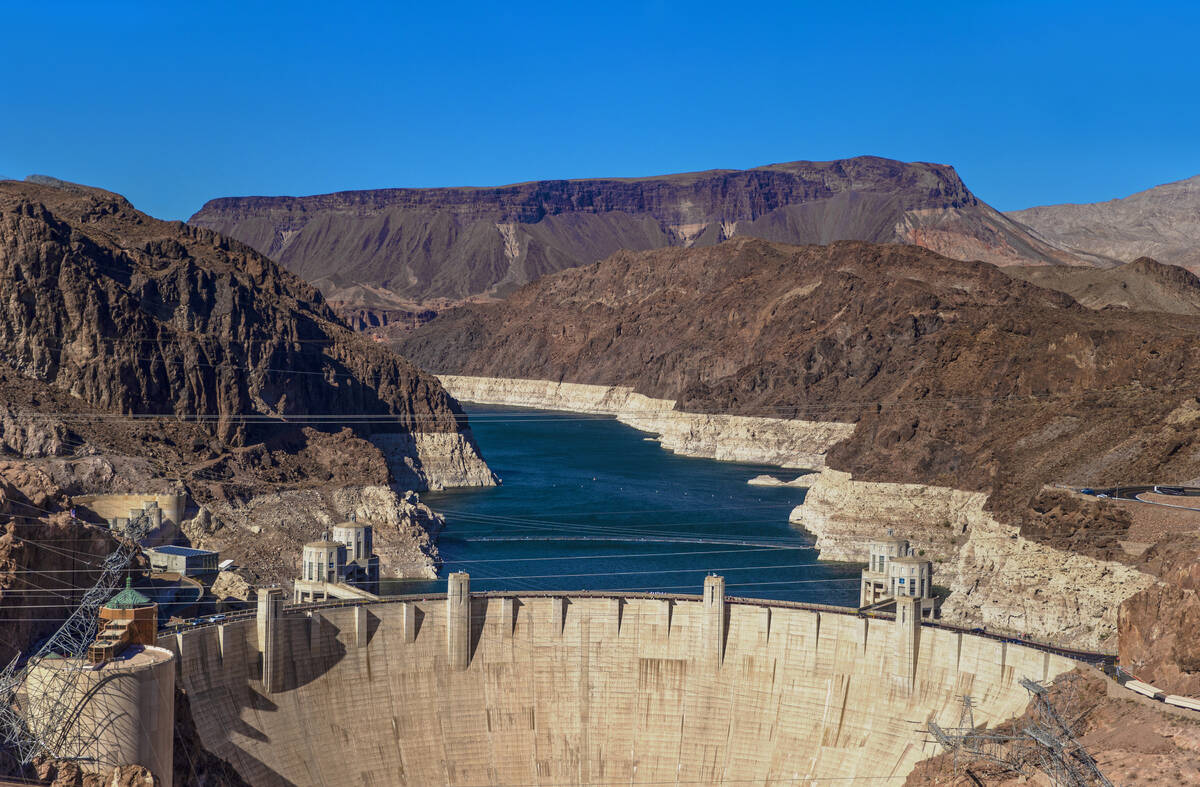Nevada, 2 other states agree to buoy Lake Mead elevation

Three states and the federal government signed an agreement Wednesday that seeks to slash water usage from Lake Mead in an effort to prevent the reservoir from falling to a critically low level.
Water agencies in Nevada, California and Arizona joined the U.S. Bureau of Reclamation in signing the so-called “500+ plan,” a new effort to buoy Lake Mead’s elevation by about 16 feet over the next two years.
The move was met with applause at the Colorado River Water Users Association conference in Las Vegas, where hundreds of water officials from across the West gathered to discuss the future of a parched river that about 40 million people rely on for water.
“In short, we’re not going to abandon the Colorado River,” Adel Hagekhalil, general manager of the Metropolitan Water District of Southern California, said during the signing ceremony. “We’re not going to turn our backs to it. We’re not going to turn against each other.”
Lower basin states will pitch in $100 million for the plan and the federal government will commit another $100 million. Individual plans to meet the goal of leaving 500,000 acre-feet in Lake Mead per year in 2022 and 2023 are still in the works, but Wednesday’s agreement represents a commitment from the lower basin to scale back consumption.
An acre-foot of water is enough to cover an area about the size of a football field in 1 foot of water. It is about what two Las Vegas Valley homes use over the course of 16 months.
Who’s chipping in?
One commitment that is a done deal is a contribution of nearly 130,000 acre-feet by the Gila River Indian Community in Arizona. Tribal leader Gov. Stephen Roe Lewis said his community hopes to repeat its contribution in 2023.
“Now this demonstrates the vital role that sovereign, tribal nations can and are playing in helping to preserve the Colorado River,” Lewis said.
Tom Buschatzke, director of the Arizona Department of Water Resources, said officials are in the process of wrapping up other deals, and that he is confident the 500,000 acre-foot contribution needed for 2022 will be met.
“Again, we have various boards, councils and governing bodies that need to review these potential agreements and we don’t want to get too far ahead of them,” he said. “That might have a chilling effect.”
He said he wants to get all of the deals finalized in time for the U.S. Bureau of Reclamation to plug the contributions into its modeling for the agency’s August version of monthly water level projections. Officials use the August report when determining shortage conditions for Lake Mead.
According to the December report released Wednesday, Nevada, Arizona and Mexico could face deeper cuts as early as 2023. That report does not consider contributions from the new agreement.
Buschatzke’s department is contributing $40 million to the effort, with the Central Arizona Project contributing another $20 million. The Metropolitan Water District of Southern California will also contribute $20 million.
Nevada will contribute $20 million to the plan, but has no additional conservation projects on deck to contribute additional water to the 500,000 acre-foot goal, Southern Nevada Water Authority General Manager John Entsminger said.
That’s largely because Nevada has the smallest share of the river, water authority spokesman Bronson Mack said.
“We are continuing to make conservation gains locally, however,” Mack said. Those gains are not going toward the conservation goal set up in the plan, he said.
River remains parched
Addressing conference attendees Wednesday morning, Entsminger did not shy away from confronting the grim reality the Colorado River faces.
“In 2021, water was scarce and pain was plentiful,” he said. The year ended up being the second-driest in recorded history, he said.
The snowpack that feeds the Colorado River was near average this year, but dry conditions and warm temperatures affected runoff into the river, which ended up being only about a third of average.
Entsminger called the situation in the Colorado River Basin a sobering moment, and emphasized an “all hands on deck” approach to addressing challenges.
The agreement signed on Wednesday comes just months after the federal government declared a water shortage for Lake Mead.
Between that declaration and a 2019 drought response agreement, Nevada’s allocation of water next year will take a 21,000 acre-foot cut.
Before Wednesday’s agreement, Arizona, Nevada and Mexico were scheduled to cut back their water allocations by 613,000 acre-feet in 2022, with the bulk of that, 512,000 acre feet, coming from Arizona. The 500+ plan tacks on additional reductions in usage.
The water level projections that led to the shortage declaration on Lake Mead also triggered a provision in the 2019 drought plan that forced the lower basin to discuss ways to prevent the reservoir from falling below an elevation of 1,020 feet. Wednesday’s agreement came from those negotiations.
Lake level is measured in elevation above sea level, not depth. Lake Mead’s elevation on Wednesday was 1,065 feet, leaving the reservoir at 34 percent full.
Contact Blake Apgar at bapgar@reviewjournal.com or 702-387-5298. Follow @blakeapgar on Twitter.